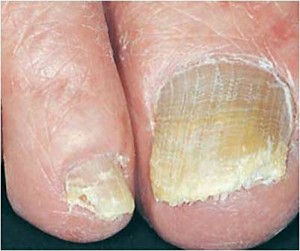fungal infections
Why Our Toenails Thicken As We Age
Many of our podiatry patients remark on how thick their toenails become as they enter (and pass) middle age. Their toenails become notably tougher to trim, which makes the possibility of cuts to the skin around the nails a real possibility. Thickened toenails also splinter easily.
[caption id="attachment_4884" align="alignleft" width="300"] Toenails thicken due to aging, but other factors may also be at play.[/caption]
Toenails thicken due to aging, but other factors may also be at play.[/caption]
Unfortunately, thickening toenails are a by-product of aging, in most cases. As we age, our toenails - and fingernails - slow their growth rate, and the nails thicken because the nail cells, called onychocytes, sort of pile up. Fingernails appear to thicken less, probably because we tend to them more often with filing and buffing, which thins them.
But in addition to this natural thickening of the nails, other factors may be at play also. Among them are trauma, fungal infections, and impaired circulation. Feet are under constant stress from falling objects, stubbing injuries, poor foowear, closed-in footwear, and athletic activities. All of these conditions can alter the cells from which the nails grow, and if one tends to stub or injure the same toe, the nail plate can easily become thickened or disfigured.
Peripheral arterial disease, or P.A.D., a vascular disease which restricts blood flow to the extremities, can also cause thickened, brittle toenails. Fungus also plays a key role, as it thrives in the moist, dark interior of a shoe. Besides causing the toenail to thicken, a fungal infection may also cause the nail to yellow, become brittle, separate from the nail bed, and possibly emit a foul odor. In this case, your podiatrist may recommend trimming and cleaning (debridement) the toenail, a prescription topical creme or prescription oral medicine.
Reasons our toenails thicken
- Aging
- Fungal Infections (onychomycosis)
- Peripheral Arterial Disease
- Trauma
- Psoriasis (accompanied by red, scaly patches)
How to safely trim thickened toenails
**If you're diabetic, have peripheral arterial disease, or have diabetic peripheral neuropathy, a podiatrist should trim your toenails. Patients with these conditions frequently have a loss of sensation in the toes, and run the risk of wounding the skin or cutting too deeply when trimming the nails.
- Soften your toenails by soaking them in warm water for 10 minutes, then dry thoroughly.
- With a nail nipper, cut straight across the top of the toenail.
- Use small cuts straight across the toenail to avoid splintering, which may cause an infection.
- Do not round the toenails at the corner - this reduces your chance of developing an ingrown toenail
- With an emory board or nail file, gently file the edges of the cut toenail to remove sharp corners or edges which may catch on your sock.
Besides debridement, there are few treatment options to alleviate the thickening of toenails due to the natural course of aging. If however, your toenails are thickening due to one of the other causes mentioned above, your podiatrist will discuss a course of treatment with you.
